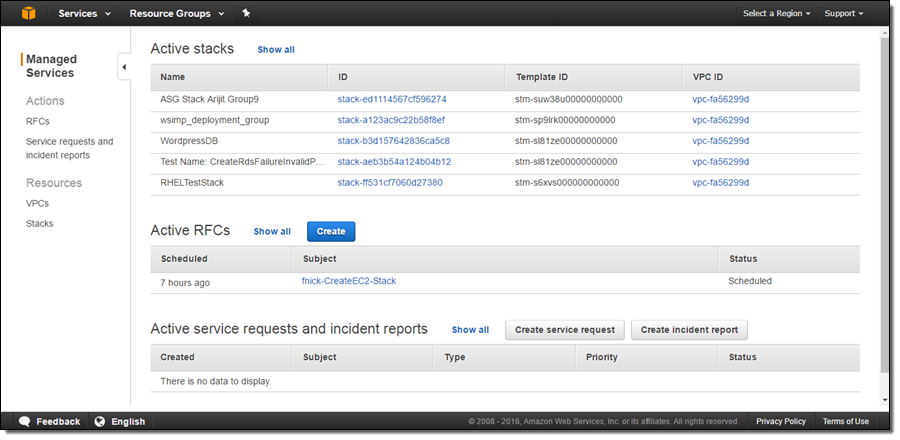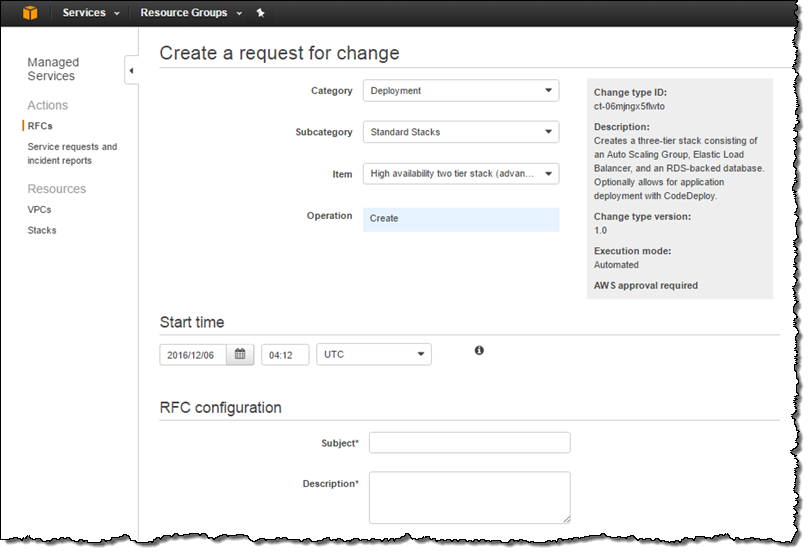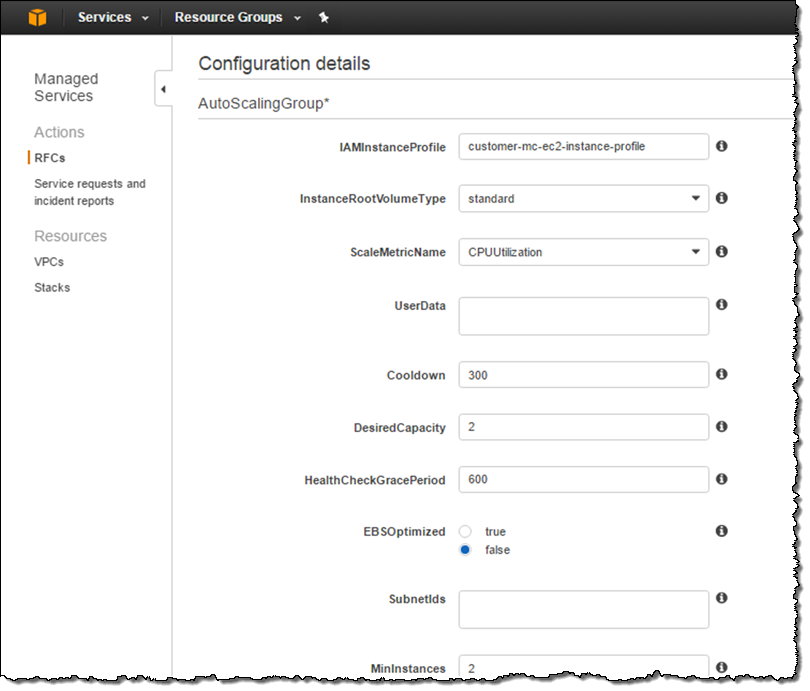Category: AWS Managed Services
AWS Managed Services – Infrastructure Operations Management for the Enterprise
Large-scale, enterprise data centers are generally run “by the book.” Policies, best practices, and operational procedures are developed, refined, captured, and codified, as part of responsible IT management, often with an eye toward the ITIL® model. Ideally, all infrastructure improvements, configuration changes, and provisioning requests are handled in a process-oriented fashion that serves to impose some discipline on the operation of the data center without becoming overly complex or bureaucratic. With IT staff responsible for provisioning hardware, installing software, applying patches, monitoring operations, taking and restoring backups, and dealing with unpredictable operational and security incidents, there’s plenty of work to go around.
These organizations have been looking at the AWS Cloud and want to take advantage of the scale and innovation that it offers, while also looking to become more agile and to save money in the process. As they plan their migration to the cloud, they want to build on their existing systems and practices, while also getting all of the benefits that the cloud has to offer. They want to add additional automation, make use of standard components that can be used more than once, and to relieve their staff of as many routine operational duties as possible.
Introducing AWS Managed Services
 Today we are launching AWS Managed Services. Designed for the Fortune 1000 and the Global 2000, this service is designed to accelerate cloud adoption. It simplifies deployment, migration, and management using automation and machine learning, backed up by a dedicated team of Amazon employees. AWS MS builds on AWS and provides a set of integration points (APIs and a set of CLI tools) for connection to your existing service management system. We’ve been working with a representative set of AWS enterprise customers and partners for the last couple of years in order to make sure that this service meets a very wide range of enterprise requirements.
Today we are launching AWS Managed Services. Designed for the Fortune 1000 and the Global 2000, this service is designed to accelerate cloud adoption. It simplifies deployment, migration, and management using automation and machine learning, backed up by a dedicated team of Amazon employees. AWS MS builds on AWS and provides a set of integration points (APIs and a set of CLI tools) for connection to your existing service management system. We’ve been working with a representative set of AWS enterprise customers and partners for the last couple of years in order to make sure that this service meets a very wide range of enterprise requirements.
AWS MS is built around the concept of a Virtual Data Center that is linked to one or more AWS accounts. The VDC consists of a Virtual Private Cloud (VPC) which contains multiple Deployment Groups which consist of Multi-AZ subnets for a DMZ, shared services, and for customer applications. Each application or application component is packaged up into a Managed Stack.
Here’s a brief overview of the feature set:
Incident Monitoring & Resolution – AWS MS manages incidents that are detected by our monitoring systems or reported by our customers. It correlates multiple Amazon CloudWatch alarms and looks for failed updates and security events that could impact the health of running applications. Incidents are created within AWS MS for investigation and are then resolved either automatically or manually by AWS engineers. False positives are used to improve our systems and processes, allowing AWS MS to improve over time by drawing on data collected at scale.
Change Control – AWS MS coordinates all actions on resources. Changes must originate with a change request (an RFC, or Request for Change), and can be manual or scripted. AWS MS makes sure that changes are applied to individual stacks on an orderly, non-overlapping basis. It also holds all incoming manual requests until they have been approved.
Provisioning – AWS MS includes a set of predefined stacks (application templates), each built to conform to long-established AWS best practices. The stacks contain sensible defaults, any of which can be overridden when the stack is provisioned.
Patch Management – AWS MS takes care of the above-the-hypervisor patching. This includes operating system (Linux and Windows) and infrastructure application (SSH, RDP, ISS, Apache, and so forth) security updates and patches. AWS MS employs multiple strategies, patching and building new AMIs for cloud-aware applications that can be easily restarted, and resorting to in-place patches for the rest.
Security & Access Management – AWS MS manages your approved third-party applications from AWS Marketplace, starting with Trend Micro Deep Security to look for viruses and malware and to detect intrusions on managed instances. AWS MS makes extensive use of EC2 Security Groups and manages controlled, time-limited access to production systems.
Backup & Restore – Each stack is backed up at a specified frequency. A percentage of the backup snapshots are tested for integrity and a run book is used to bring failed infrastructure back to life.
Reporting – AWS MS provides a set of financial and capacity management reports, delivered by a dedicated Cloud Service Advisor using AWS Trusted Advisor and other tools. The underlying AWS CloudTrail and Amazon CloudWatch logs are also accessible.
Accessing AWS Managed Services
You can connect AWS Managed Services to your existing service management tools using the AWS MS API and command-line tools. You can also access it through the AWS Management Console, but we expect API and CLI usage to be far more popular. However you choose to access AWS MS, the basic objects and operations are the same. You can create, view, approve, and manage RFCs, service requests, and incident reports. Here’s what this looks like from the Console:

Here’s how a Request for Change (RFC) is created:

And here’s how technical users can customize the RFC:

After a change request has been entered, approved, and scheduled, AWS MS supervises the actual change. Automated changes take place with no further human interaction. Manual changes are performed within a scheduled change window using temporary credentials specific to the change. AWS engineers use the same mechanisms and follow the same discipline. Either way, the entire process is tracked and logged.
Partners & Customers
AWS Managed Services was designed with partners in mind. We have set up a pair of new training programs (AWS MS Business Essentials and AWS MS Technical Essentials) that will provide partners with the background information needed to start building a practice around AWS MS. I expect partners to help their customers connect their existing IT Service Management (ITSM) systems, processes, and tools to AWS MS, assist with the on-boarding process, and manage the migration of applications. There are also opportunities for partners to use AWS MS to provide even better levels of support and service to customers.
As I mentioned earlier, we’ve been working with enterprise customers and partners to make sure that AWS MS meets their needs. Here are a few observations that they shared with us.
 Tom Ray of Cloudreach (“Intelligent Cloud Adoption”), an AWS Premier Partner:
Tom Ray of Cloudreach (“Intelligent Cloud Adoption”), an AWS Premier Partner:
We see AWS Managed Services as a key solution in the AWS portfolio, designed to meet the need for a cost effective, highly controlled AWS environment, where the heavy lifting of management and control can be outsourced to AWS. This will extend our relationship even further, as Cloudreach will help customers design, migrate to AWS Managed Services, plus provide application level support alongside AWS.
Paul Hannan of SGN (a regulated oil & gas utility):
SGN’s migration to cloud is based upon improving the security and durability of its IT, while becoming more responsive to its business and customer service needs – all at a lower cost. We decided the best way for us to manage the migration into AWS, at the lowest risk to ourselves, was to partner with AWS. Its managed service team has the expertise to optimise the AWS platform, allowing us to accelerate our understanding of how to best manage the infrastructure within AWS. It’s been a real benefit working with a partner which recognises our desire to always put our customer first and which will pull out all the stops to achieve what’s needed.
Available Now
AWS Managed Services is available today. It is able to manage AWS resources in the US East (Northern Virginia), US West (Oregon), EU (Ireland), and Asia Pacific (Sydney) Regions, with others coming online as soon as possible.
Pricing is based on your AWS usage. To learn more about AWS MS or to initiate the on-boarding process, contact your AWS sales representative.
— Jeff;
ITIL® is a (registered) Trade Mark of AXELOS Limited. All rights reserved.